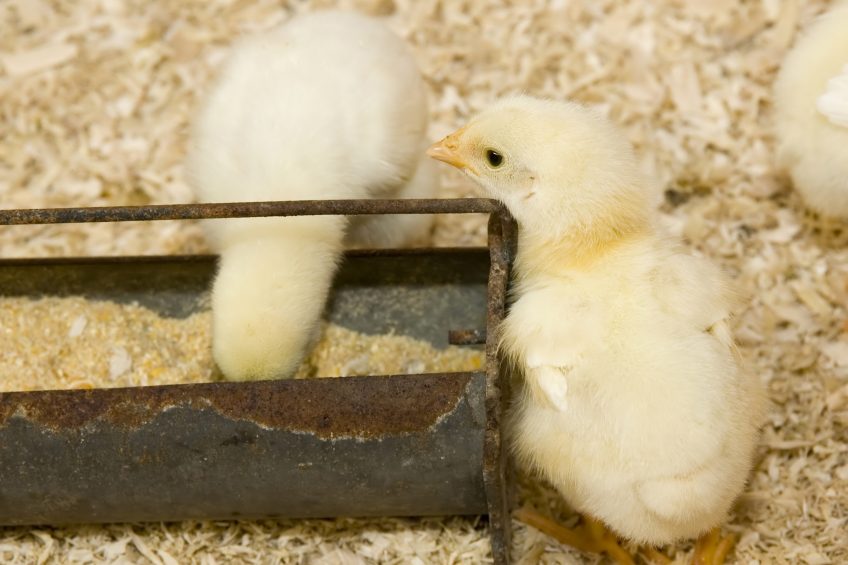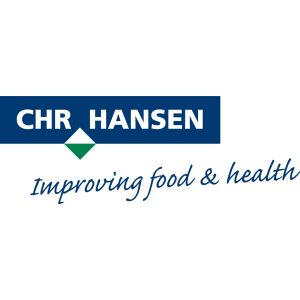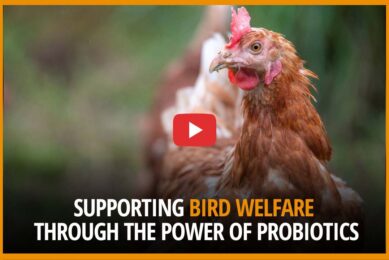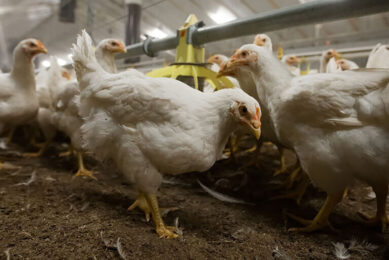Microbiome stability: Challenge of modern broiler production

In poultry, we focus a lot on achieving a healthy gut since a well-functioning gut is the key engine for growth, health and welfare of the birds. Robustness of the microbiome is closely linked to gut health. That is why good care should be taken of the chicken’s gut microbiota as part of all management practices.
In recent years, knowledge about the gut microbiome has increased tremendously in both humans and animals. Actually, for humans, the microbiome is approximately 1.5kg of bacteria that we are carrying every day. These bacteria and other microorganism that are part of the gut microbiota are mainly favourable to humans and are acting at the interface of the external world and our body. There is much research leading to the conclusion that this microbiome has an unbelievable impact, not only on the digestive system, but also on the rest of the human or animal body. It influences the immune system, the central nervous system and can as such even affect mood and behaviour.
A diverse and functional potential of the microbiota
Microbiome stability can be defined as the optimal robustness over time between the beneficial bacteria and the pathogenic or non-beneficial bacteria in the intestinal tract of the birds. Microbiome stability supports optimal intestinal health, a better welfare and thus a higher sustainability of poultry production (Figure 1).
Figure 1 – Microbiome stability can be defined as the optimal robustness over time between the beneficial bacteria and the pathogenic or non-beneficial bacteria in the intestinal tract of the birds.

During its life, a chicken faces many challenges to maintain its microbiome stability. The former way to manage pathogens and thus the microbiota by using massive amounts of chemicals (zinc, copper, antibiotics) is over. At the same time, it is still a dream to remove pathogens from modern poultry production, so viable alternatives are needed. Additionally, the use of highly digestive substances is becoming increasingly inefficient from an economic standpoint. As a result, the strategic nutritional formulation is moving to less security and safety for the birds. More use of wheat, Distiller’s Dried Grains with Solubles (DDGS), sunflower meal, rapeseed meal or even peas instead of soy meal and corn is being seen. So not only are less chemicals accepted by the consumers and authorities, but also economically we are looking for alternative raw materials sources, for example, as a by-product. Ultimately, the pathogens are still there, and the physiology of the birds is even more challenged with higher growth rates and feed intake. Genetic enhancements are ongoing, but eventually it takes time for birds to develop and mature their physiological enzyme system, immune system, digestive structure of villi and microvilli.
Maintaining microbiome robustness by making sure the digestive tract is populated with a diverse and functional microbiota is crucial for the chicken to withstand the challenges of being a production animal. Previous nutritional and farm management practices were to remove all pathogens. Nowadays more holistic approaches are being looked at for obtaining a robust gut microbiota that provides protection against pathogens and shapes the digestive physiology and the immune system in beneficial ways. Robustness depends on the diversity of the microbiome, so it is not enough just to have the presence of a few different beneficial microbes, like cultivating hectares of only one crop. Too little so-called beta diversity will make the microbiota more susceptible to challenges, and thus highly unstable. One can say that if changes are introduced in the life of the chicken (like feed transition as a key example), there is a lack of a plan B to adjust to this new reality because there are simply too few good bacteria to carry the torch. On the other hand, having a good diversity of different microbes with beneficial properties allows adjustment, adaptation and the ability to take advantage of the different attributes of the variety of favourable species and strains. A lack of diversity makes the whole digestive system extremely fragile and very susceptible to any change.
In that sense, the ideal is to achieve a microbiota in the gut which looks like a forest: many vegetal, a lot of diversity of herbs, fungi and plants, and ultimately huge trees which dominate the rest of the vegetal, making it difficult for the bad herbs to become dominant. This is achieved by the natural competition on sun, earth and water and their established dominance (Figure 2).
Figure 2 – Maintaining function and diversity, a paradigm shift in modern broilers.

A high diversity provides more functional potential to the microbiota. The more diverse, the more robust and stable it will be. The favourable bacteria will be so dominant that they will de facto prevent pathogenic bacteria to multiply. Just like trees in the forest dominate the other vegetal species, the established dominance dictates the natural competition.
A challenging period in the life of a chicken
When we consider the life of a chicken, not much is currently done to achieve microbiome robustness and stability and many challenges are rising on the horizon. Actually, quite a lot of different events are happening due to management practices, which can affect the microbiome robustness. These challenges are shown in Figure 3.
Figure 3 – Multiple risks of losing microbiome stability during the life of a chicken.

1 st days: Feed intake and first bacterial implementation challenge
Feed can be considered the fuel of the digestive engine. When considering the chick weight and the amount of feed it needs to ingest every day, the challenge is very high. For instance, day 1, the ratio between the feed intake and the weight is superior to 30%! For a 4kg human baby, this would represent the ingestion of 1.2kg of food and something like 2 litres of water. Feed, water, heat and oxygen are the key elements for bacterial establishment during the first days of life. Since the digestive tract of the newly hatched chicken is virtually sterile, or comparable to a desert with respect of vegetation, it is easy to understand that there is a massive opportunity for any pathogenic bacteria to grow in such an environment without competition from good bacteria.
A lot of research shows that this first implementation is based on chance. Any bacteria present in the environment of the day-old birds is likely to be present in the gut of the chick. It explains why there is typically a gram-negative challenge (E coli, Salmonella) early in life. These bacteria have the capacity to multiply quickly and to take advantage of the new environment: a desert where feed, water, heat and oxygen are in abundance, but no other vegetation to compete these resources. Besides causing pathogenic infections, these bacteria take up the ecological niches in the digestive tract, making it more difficult for more beneficial bacteria to establish. As a result, it is likely that it will lead to a less stable and robust microflora which will require antibiotic treatment to keep the balance in check and provoke subsequently mortality.
2 nd and 3 rd week: the microbiota shift
The feed intake challenge is diminishing in the 2nd and 3rd weeks of the chick’s life (still 20% of feed intake over the individual weight). However, there are other reasons making these weeks very challenging for the microbiome. A natural part of the microbiome establishment is the lower availability of oxygen in the gut happening after the aerotolerant species have established. At this point in time, the strict anaerobic bacteria can colonise. The strict anaerobes are favourable for the bird and gram-positive. However, one of them is Clostridium perfringens, a pathogen causing necrotic enteritis. Typically, these bacteria reside at the very end of the digestive tract, in the caeca where oxygen is very low, but they can take advantage of the retro-peristaltic movements of the chicken gut to move up and start proliferation in the small intestine. Clostridium perfringens proliferates, leads to an unhealthy balance of the microbiota called dysbiosis, eventually resulting in necrotic enteritis between day 14 and day 18. This is a very typical observation which is also simultaneous to a brutal feed transition between starter and grower diet. It can be even more dramatic in case of vaccination during this period.
4 th and 5 th week: Coccidia and mucus production
These 2 weeks are dominated by the Eimeria challenges which will occur in all farms, regardless of the vaccination programme or chemical/ionophore-based programme in place. There will be sporozoites of coccidia (either wild or vaccinal strains) which will be in close contact with the epithelial cells of the intestine. As a matter of defence, the first line of protection will be an increased production of mucus by the goblet cells. The aim will be to build and reinforce a wall of mucus to protect the intestine from the parasites’ attack. Unfortunately, some pathogens may take advantage of this mucus production. We call them mucolytic bacteria. Not only are they able to survive and multiply within the newly produced layers of mucus but also, they can use the mucus as a source of energy for their own development. As a result, they multiply in situ, in very close contact with the top of the epithelial cells. It is obvious that it will lead to a digestive syndrome so-called dysbacteriosis or dysbiosis. Ultimately, this may be even more damaging when there is the production of digestive toxins such as alpha or net-B toxins produced by Clostridium perfringens.
At the same time, this is a period where the broiler producer wants to make the most profit out of its production. The feed intake and the growth rate are becoming very high. This is the period when feed efficiency matters the most. Thus, it is even more critical to maintain a healthy and robust microbiome. Each day of a poorly balanced microbiota can lead to a potential loss of 80 to 100g of body weight/bird. That is equal to 0.08 to 0.1 € /bird of revenue. Considering production of 10,000,000 birds/year, the loss becomes a significant amount of money (€ 800,000 to 1,000,000).
In addition, this is a period of intense feed intake stress for the microbiome: brutal transition from grower to finisher feed followed by another transition from finisher to withdrawal feed. When the market needs are there, the poultry producer may use the thinning method when part of the flock will be slaughtered while the rest will stay in place for further growing time in the barn. This is requiring a brutal stop in feeding and drinking the animals for carcass quality reasons. This leads to a complete disruption of microbiome. In a couple of hours, the intestinal content and thus the nutrients, are reduced to a minimal presence, as well as the water content of the digestive tract. When the thinning is finished, the birds typically turn to an over consumption of feed in a short period of time. The microbiome, already challenged by the fasting period now has more feed to be used for rapid development. How do we manage this? Well, we pay a little attention to this practice from a microbiome standpoint. However, there is no doubt that this is completely disturbing the microbiome stability and robustness.
What do we need to do to achieve and maintain microbiome stability?
The modern poultry industry should consider microbiome stability as a key goal to achieve sustainable poultry production in the future. This is probably the very early stage of a concept which will revolutionise our approach to the intestinal content of the chicken. Whatever the tools, techniques, approaches available in the future, 3 key goals need to be achieved:
- To seed the gut with favourable bacteria at the right time, probably as early as possible: day 1 and or even in ovo. Seeding with good probiotic bacteria helps prevent overgrowth of bad bacteria. At the same time, it paves the way of the establishment of a well-balanced, well-functioning and highly diverse microbiota. The early seeding and colonisation is the first strategic component of the microbiome stability.
- The need to support the multiplication of the favourable bacteria and to allow them to dominate most of the microbiota. This can be achieved by creating a favourable micro-environment in the gut. Well selected sporulated probiotics are dedicated to creating such environment. Other probiotic strains help by competing chemically via bacteriocins or through enzymes that works against potential pathogenic bacteria.
- There is a need to decrease, as much as possible, undigestible substrates that are potential feed for fermenter and unfavourable bacteria. This ideal substrate for pathogenic bacteria can subsequently lead to enteritis and microbiota unbalance. Recent research in the probiotic world has shown that very specific strains are able to behave as an in-situ enzyme factory, releasing them directly into the gut. Thus, these favourable bacteria can transform the indigestible intestinal content into digestible and valuable nutrients for the birds and not for the microbiota.
Conclusion
We are at the very beginning of a new era for knowledge and understanding of the chicken’s microbiome. We are scratching the surface of something bigger. However, what we know from other species, including humans, can make us optimistic. The progresses will be fast. It will undoubtedly allow the development of new solutions better accepted by modern poultry production and by consumers.
Author: Christophe Bostvironnois and Randi Lundberg, Chr Hansen, Denmark




